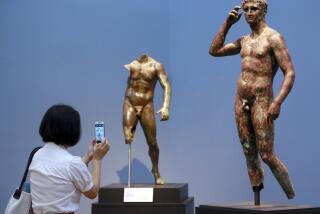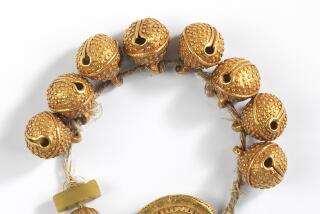Greeks carry torch for Marbles
- Share via
ATHENS — For Greeks and others who have long campaigned for the return to Athens of the famous Elgin Marbles, this was supposed to be their big year.
Greece is hosting the Summer Olympic Games, which open Friday. What better showcase for bringing the precious sculptures home?
But activists involved in the struggle have had to put their hopes on hold. It looks as though the 2,500-year-old marble sculptures, ripped from the walls of the Parthenon two centuries ago, will continue to be housed and displayed at the British Museum in London.
To take possession, Greece, at the very least, had to finish building a museum that would serve as a suitable resting place for the elaborate works of ancient art. Instead, the new Acropolis Museum -- like many other construction projects in Athens these days -- has been hopelessly delayed.
And with all priority placed on finishing Olympic venues, there is virtually no chance that the museum can be completed until next year at the earliest.
This is only the most recent setback in one of history’s most contentious cases involving the repatriation of art to nations of origin, a controversy that spans continents, cultures and millenniums. Italy recently agreed to return an obelisk to Ethiopia that had been looted during Rome’s colonial ventures in Africa, but that’s rare. Museums from Paris to Malibu resist efforts by nations like Greece and Egypt to recover what they see as their ancient heritage.
“Everything hinges on a new museum” in Athens, said Freddie New, campaign manager for a British-based group called Marbles Reunited, which formed earlier this year to push the relics homeward.
“The most important thing Greece can do is demonstrate it has a home” for the marbles, New said.
The sculptures are popularly known as the Elgin Marbles, named for Thomas Bruce, 7th Earl of Elgin, the British ambassador to what was, in the early 19th century, part of the Ottoman Empire. (Greeks and others, including the British Museum, today prefer the name of Parthenon Marbles or sculptures.)
Using pickaxes and saws, Elgin led a team in the early 1800s in the hacking of just more than half of the marble friezes that decorated the Parthenon. Even before the Earl of Elgin, some of the sculptures lay scattered on the ground in disrepair.
Purportedly with the permission of the sultan who ruled the region at the time, Elgin in 1806 hauled the fragments back to London for what he said was their safekeeping.
In 1816, he sold them to the British Museum, where they have resided ever since. Greece gained independence in 1833 and almost immediately demanded the return of its precious antiquities.
In their original state, the “marbles” are in fact a series of panels, totaling about 400 feet in length, that depict a majestic parade of horses, riders, votive bearers, sacrificial animals and Olympian gods. They are the work of Phidias, considered one of the world’s greatest sculptors, and, in the opinion of many classicists and art historians, should be viewed together as a single masterpiece.
Today, perched atop the Acropolis hill overlooking this rather chaotic Greek capital, the Parthenon, an ancient, sacred temple that symbolizes the glorious era of Socrates and embodies this nation’s very identity, looks almost naked without its friezes; blotches on the upper fringe of the building look like clumsy erasure marks.
Officials at the British Museum and others who support leaving the marbles where they are argue that Greece cannot properly care for them and that their current home gives public access to the wider global community.
With nearly 5 million visitors a year, the British Museum exhibits the sculptures in the context of art’s evolution through history and the world, director Neil MacGregor has argued. Britain’s Conservative Party argued before Parliament recently that repatriating the marbles would “rip the heart out” of the British Museum.
Paul Anastasi, a spokesman for the city of Athens, maintained that returning the sculptures to their origin would finally allow curators to “reconstitute them as a whole, in their natural environment.”
The government here had hoped this could be achieved in time for the Olympics. It relaxed its ownership claim and said it would be content, for now, with a “loan” from the British Museum. And if authorities from the London art house waited until the last minute to release the sculptures, Athens would still be able to display them appropriately, Anastasi said.
But not even supporters of the “return-the-marbles” cause believe that at this point.
And the British Museum does not believe that Greece will really be content with a loan since it has not recognized what the museum considers to be its lawful ownership of the pieces.
“We stress that whatever happens with the new Acropolis Museum, the Greek government does not recognize the [British Museum] trustees’ ownership, so it is virtually impossible for them to have discussions even over a short-term loan -- which is not what is being asked for anyway,” a British Museum spokeswoman, Kate Eustace, said in a statement.
Greek officials, much maligned for their poor handling of Olympic preparations, denied they had blown yet another chance to shine a positive spotlight on their country’s cultural heritage -- and the repatriation campaign.
The new Acropolis Museum, which was meant to house the sculptures at the foot of the famed hill and within eyeshot of the Parthenon, is part of a larger project to build an archeological park that unites the city’s many treasures and eases access for tourists.
Designed by Swiss architect Bernard Tschumi, whose vision won an international competition in 2002, the new museum has plans to dedicate its top floor to the Parthenon Marbles. It will be a rectangular, glass-enclosed gallery with maximum light for viewing, with the Acropolis ever in the background and the sculptures arranged to replicate their original position.
After winning the bid, Tschumi told the newsletter of Columbia University, where he at the time served as dean of the School of Architecture, Planning and Preservation, that he was humbled by the assignment.
“The Parthenon was the highest point of culture and worship,” Tschumi said. “The museum is a place that records those achievements. The museum will stage the work of that era while asserting a new identity.”
But construction of the museum was delayed when builders hit archeological ruins at the site. It took months of legal wrangling before construction could proceed.
And that delay sealed the fate of the campaign to bring the marbles home, at least for now.
“There can be no question of the marbles moving if there is no adequate place for them” in Greece, said New, the official with the Marbles Reunited campaign.
He and other activists said they hope Greece will make a good show of the Olympics this summer, and then that will boost the country’s case.
More to Read
Go beyond the scoreboard
Get the latest on L.A.'s teams in the daily Sports Report newsletter.
You may occasionally receive promotional content from the Los Angeles Times.







